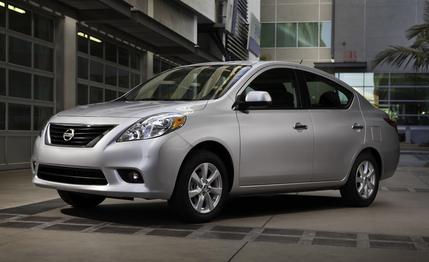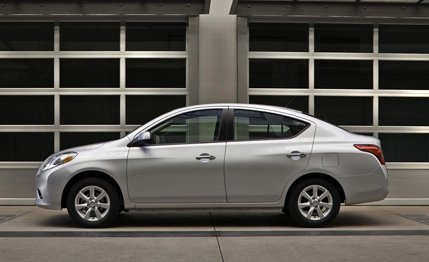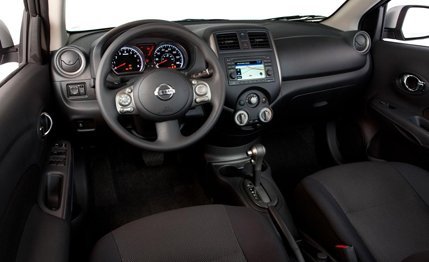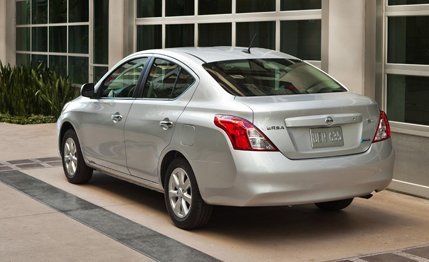 First Drive Review
First Drive Review
That buzz surrounding the entry-level beehive is a swarm of buyers aggravated by the recession and $4-a-gallon gasoline. Nissan expects this segment to double in size by 2016 and create a feeding frenzy that will attract new competitors seeking not only to fulfill demand but also to hike their makers’ CAFE standings. Preparing for the onslaught, Nissan rejuvenated its Versa four-door for 2012. The five-door Versa hatchback carries on unchanged until next year.
The new model is a serious upgrade of a car whose previous claims to fame were lots of interior space and the lowest base price on the market. In contrast to subcompacts like the Ford Fiesta, the Versa has been and continues to be a proud member of the EPA/SAE compact-sedan category, with 90 cubic feet of passenger room and a 14.8-cubic-foot trunk. The back seat is actually the focal point of the new edition, in large part because it offers chairlike seating for three and legroom topping—if not plushness remotely approaching—that found in the BMW 5-series, Mercedes-Benz E-class, and short-wheelbase Lexus LS.
V for…Well, Not Vendetta
With the base price edged up a bit to $11,750, the Versa hangs tight to its cheapest-alternative-to-a-used-car status while vaunting a more attractive wrapper (at least in person). Built on a new global V platform, the 2012 Versa keeps the same 102.4-inch wheelbase and 66.7-inch width but incorporates a shorter front overhang, a 2.7-inch-longer rear overhang, and an overall length trimmed by 0.6 inch to 175.4. The longer tail adds one cubic foot of trunk volume to last year’s 13.8 cubes.

Lowering the roof by 1.2 inches to 59.6 reduces headroom a bit—and total interior volume drops from the 94.3 cubic feet boasted by last year’s car—but the new edition strikes a better balance between function and form. Up front is the first use of Nissan’s new signature sedan grille; the big change out back is a sparkling blue-and-chrome “Pure Drive” badge to herald the company’s environmental enlightenment and—more specifically—efforts to improve mileage and curb CO2 emissions.
Nissan engineers trimmed more than 150 pounds from the platform while reducing the parts count by 20 percent. They also simplified the engine lineup, dropping the optional 122-hp, 1.8-liter four. The redesigned 1.6-liter four-cylinder has an aluminum block and head and a molded-plastic intake manifold. The bore, the stroke, the compression ratio, and the 6500-rpm redline are unchanged from 2011’s 1.6. Citing cost as the obvious concern, this engine is still port- instead of direct-injected, although the number of injectors has been doubled from four to eight in the interest of a more efficient spray pattern to foster complete combustion.

1.6 Is the Displacement, Not the Horsepower Count
The new engine makes 109 hp at 6000 rpm (an increase of 2) but produces a touch less torque (107 lb-ft at 4400 rpm, down from 111). Few customers opt for the five-speed manual transmission, which is now offered only in the base Versa S and was not available for test driving at the Versa’s Seattle launch. Thanks to the reduced weight and other efficiency gains, city mileage for the manual rises 1 mpg to 27, and highway mileage climbs from last year’s 34 to 36.
The better news is a more civilized CVT. Punching the throttle still catapults the engine to 4800 rpm, but the rubber-band feel is subdued in normal driving. A planetary gearset added to the belt-and-pulley system stretches the ratio spread by 21 percent, boosting EPA city mileage to 30 mpg (from the 28 mpg of last year’s most efficient setup, the 1.8-liter engine and the CVT). The new 38-mpg highway rating is a 4-mpg gain.
Finally, We Make Fun of the Name
In addition to the two transmission choices, there will be three trim levels when the 2012 Versa goes on sale this August, from the $11,750 base S to the high-zoot SL, which tops out at $18,350 fully loaded. Included as standard equipment on the base Versa S are air conditioning, a tilting steering wheel, six airbags, and stability control. The CVT is $1770 on the S and included on the two other trims. The mid-level model is the SV, which adds cruise, power windows and locks, keyless entry, and fancier seat cloth, and costs $15,320. To that, the $16,320 SL adds aluminum wheels, fog lights, a 60/40 split-folding rear seat, and cloth door trim.

Aside from the CVT that costs extra on the S, each trim offers only one options package—it is rolled in as standard equipment on the next-highest level—and a smattering of small dealer-installed options. On the S, Nissan offers a cruise-control bundle that requires the CVT, costs $350, and adds two more speakers for the stereo, plus a trunk light. On the SV, the big extra is a $350 Convenience Group that adds Bluetooth, an iPod connector, steering-wheel-mounted audio controls, map lights, and vanity mirrors. The SL offers a $700 Tech package incorporating navigation and XM radio.
As expected in this price class, the Versa’s interior suffers from granite-hard surfaces and flagrant cost cutting. The strut-type front suspension, the torsion-beam rear axle, and the rear drum brakes are engineered for dependable long-haul service not driving euphoria. That means your time behind the wheel will inspire no thoughts of touring the French Riviera in a Porsche Boxster. But a Nissan Versa will probably keep you on your commuting schedule for just pennies per mile, which is the whole idea behind driving a cheap new car instead of rolling the dice with a used ride.